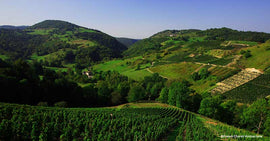Battle of the Noirs
Champagne is primarily made from three grapes: Pinot Noir, Pinot Meunier and Chardonnay - and generally in that order. Pinot Noir is the most widely planted varietal in the region - there is actually more of it in Champagne than in Burgundy - followed by Pinot Munier, which accounts for some 32% of the acres under vine. Surprisingly, given Champagne’s yellow to gold color wheel, the only white grape in the trio is planted on slightly less than a third of the vineyard land; the 100% Chardonnay “Blanc de Blancs” category accounts for just 5% of the overall product. (There are actually four other allowable grapes - Pinot Gris, Pinot Blanc, Petit Meslier and Arbane - but collectively they make up a miniscule 0.3% of plantings.)
Most Champagne is in fact a blend of the three dominant varietals, but this month we are going to focus on the aforementioned Pinots. Pinot Noir is present in the historical record as early as the fourteenth century, when it was already prized by clergy and nobility in eastern France and southern Germany. Pinot Meunier is actually a clone of Pinot Noir, and came to prominence due to its ability to ripen more evenly than its parent; it is primarily grown in Champagne’s colder, northern areas, where Pinot Noir tends to struggle. The prefix “Pinot” is thought to derive from the grape clusters resemblance to pine cones - and in the glass the family resemblance between the two varietals remains strong enough that it is nearly impossible for even the greatest of sommeliers to tell them apart. In general though, Pinot Meunier is characterized by higher acidity and more overt fruit.
Both of our bottles this month have tell tale signs of noir. However the wines are made in different ways. Jean Vesselle’s L’Oeil de Perdrix is 100% Pinot Noir, with a lower dosage and less aging before release. The grapes are overpressed just enough to produce a singular slightly pink, not-quite-rose hue. The Leguilette Romelete Notes Noires is a 2009 vintage blend of Noir and Meunier, with more added sugar. The extra time on the lees leads to an powerful and unique iteration of Blancs de Noir. We hope the contrast allows you to savor the distinct contributions of these genetically-similar-but-not-synonymous grapes to Champagne’s peerless excellence.
Cheers!
The PlumpJack Family
|
Jean Vesselle L’Oeil de Perdrix |
|
|
From: Bouzy all Grand Cru Vineyards |
About the Winery: The family’s collection of top terroirs and generations of leadership in championing Pinot Noir are what make wines from Domaine Vesselle such eloquent examples of Blanc de Noirs Champagne. For nearly 300 years, the Vesselle family has been tilling the chalky soils of Bouzy and cultivating some of the village’s best-placed Pinot Noir vines. Wines here combine a classic Champagne elegance with the signature Bouzy power, especially in wines such as the estate’s ‘Oeil de Perdrix.’ This unique rosé is a taste of Champagne history, a style of wine long forgotten before winemaker Delphine Vesselle—to honor the traditions of her Champagne-making grandparents—brought it back with great success. When Fulgence Vesselle and his neighbors started making their own Champagne around 1900 (having sold their grapes before), they slightly over-pressed and ended up with a wine that was neither all white nor full pink - in fact, the pale orange pink of a partridge’s eye or Oeil de Perdrix. The style faded from view around mid-century, but in 1972 Fulgence's grandson, Jean Vesselle, discovered a few bottles of the old wine hidden in a wall. He was astounded by the color, freshness, and lovely aromas of this old-style wine and, beginning a few years later, launched his own interpretation of Oeil de Perdrix. It's 100% Pinot Noir pressed lightly pink and aged 3 years in bottle before release. History never tasted so good! Vinification: Average age of vines is 15-30 years. As is law in Champagne, everything is hand-harvested. Grapes are macerated briefly (less than 24 hours) for color then pressed. Fermented on indigenous yeasts in stainless steel tanks. Aged for three years in bottle. Elevage: Aged exclusively in stainless steel Assemblage: 100% Pinot Noir Dosage: 6 g/L Tasting notes: Aromas of red roses, orange zest, white pepper, light herbs. Medium-bodied yet light on the tongue; elegant, silky and balanced. Red berries, stone fruits, peppery finish. |
|
Winemaker: Delphine and David Vesselle |
|
|
Price per bottle / Price per case: $60/bottle $648/case |
|
|
Suggested Food Pairing: Chicken Cacciatore Eggplant Parmesan Bolognese Channa Masala |
|
| Champagne Leguillette Romelot Notes Noires 2009 | |
|
From: Vallée de la Marne, Charly-sur-Marne |
About the Winery and Vinification: The production of Champagne under the name Léguillette-Romelot began in 1968 when the Léguillette and Romelot combined their vineyard holdings. Today, the Maison de Champagne Léguillette-Romelot operates 8 hectares of vines in the municipalities of Charly-sur-Marne, Crouttes-sur-Marne, Villiers-Saint-Denis and Gland. Since 2015, the Maison Léguillette-Romelot has claimed the appellation "Clos du Mont Dorin". Current proprietors Laurent and Christine took over in 2000 and have always had a brisk trade on the domestic market, particularly with private customers. The domaine covers 8.2 hectares of vines, which average 40 years of age, including a small plot around the house dedicated to three arcane varieties. The wines undergo systematic malolactic fermentation, and aging en tirage is longer than the average. All grapes are hand harvested. Tragedy befell the family in the summer of 2018 when Laurent succumbed to illness at the unthinkable age of 45. Christine has taken over the reins and is showing great determination and optimism. Elevage: Stainless steel 9 months. The wine goes through full malolactic fermentation and then is on lees for 8 yrs. Assemblage: 2009 harvest of Pinot Noir and Pinot Meunier Dosage: 10 g/L Tasting notes: This is an unusual rendition of the Blanc de Noirs concept, but the result is vivid and chiseled. After 8 years sur lie, secondary development is just beginning in a Champagne that displays both power and finesse. |
|
Winemaker: Christine Leguillette |
|
|
Price per bottle / Price per case: $59 /bottle $637.2/case |
|
|
Suggested Food Pairing: Mushroom Stroganoff Chicken Marsala Tomato and Peach Salad with Feta Fried Zucchini White Bean Salad Cultured Butter and Toast |
|





